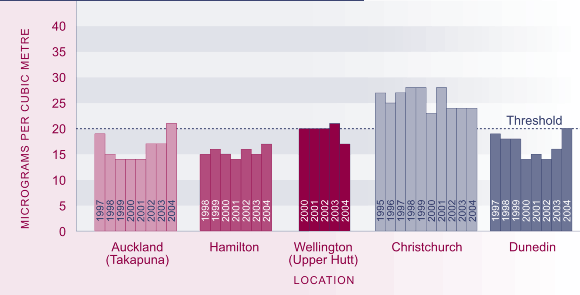Air quality
Definition
The average annual PM10 levels in selected sites above the ambient PM10 guidelines. PM10 is particulate matter that is less than 10 microns in diameter. The New Zealand ambient air quality guideline for PM10 is 20 micrograms per cubic metre (20µg/m 3) averaged annually.
Relevance
Good air quality is an important component in maintaining our quality of life, the appeal of New Zealand as a tourist destination, and the health of people, plants and animals. PM10 is the primary contaminant of concern in New Zealand and it is known to affect many people with adverse health effects. Health effects associated with this contaminant include increased premature mortality, the aggravation of existing respiratory and cardiovascular diseases, hospital admissions and emergency department visits, school absences, lost work days and restricted activity days.
Current level and trends
Figure EN1.1 shows the average annual PM10 levels in the air at selected monitoring sites in the six major cities. At the one Christchurch site used in Figure EN1.1, average annual PM10 levels were above the ambient guideline for all years between 1995 and 2004. Since 2002 there have been signs of an improvement, with the levels stabilising, though still at a level above the guidelines. The Auckland site exceeded the guideline in 2004 and appears to be on the rise. The Wellington site exceeded the guideline in 2003, but was below the threshold in 2004. The Dunedin site reached the threshold level in 2004. Recorded PM10 levels at the Hamilton site have been consistently below the New Zealand annual guideline.
Poor air quality in New Zealand is typically associated with urban areas and is a product of vehicle emissions (Auckland) and domestic home heating (nationally). Industrial and agricultural emissions are also lesser sources of PM10, as are dust pollens and sea spray, which are natural sources of small particles. Annual data presented here should not be confused with daily average PM10 concentrations, which are known to exceed health-based guidelines in 28 urban centres in New Zealand . In September 2005, new air quality standards will be introduced that are based on daily average PM10 concentrations.
Figure EN1.1 PM10 concentration in selected sites, 1995–2004

Source: Ministry for the Environment (2005) unpublished analysis
Note: Data is unavailable for: Wellington before 2000, Hamilton before 1998 and Dunedin and Auckland before 1997
International comparison
Ambient air quality is entirely location-specific and it is not possible to compare countries. For example, it is possible to compare annual PM10 in Auckland with annual PM10 in Los Angeles, but an OECD median cannot be calculated. The air quality in New Zealand 's urban areas is, however, broadly comparable with or better than a number of OECD countries.
|

